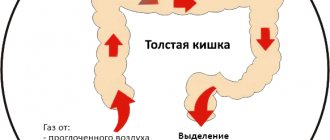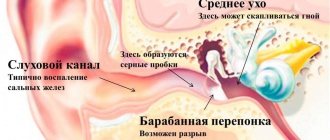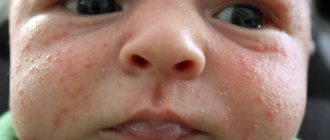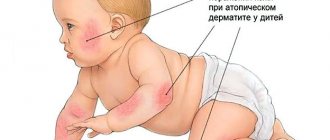Statistics show that a red or pink spot on the back of a child’s head can occur in every third case. It may be a consequence of an independent local process or a symptom of a systemic disease. In some cases, the formation exists already from birth, in others it develops after several weeks or even months. There may be several reasons that provoke the formation of a spot. Both the care of the baby and possible treatment options depend on them. In some cases, the symptom goes away on its own over time, without medical intervention. In any case, the first reasonable action when a phenomenon is detected is to contact a pediatrician or specialized doctor.
Angioma - a spot on the back of the head - as a result of a benign tumor
The most common condition characterized by the formation of a red spot is angioma. This is a benign tumor, which is a proliferation of blood vessels located under the skin. The result is a pink, red or purple stain. Such spots can be located on any part of the child’s body, but most often they are localized on the back of the head.
Angiomas form during fetal development and are most often classified as ordinary birthmarks. Most formations disappear on their own (after a few months or years). Tumors can vary in size and color, sometimes it is not a single formation, but a whole colony. In most cases, angiomas do not cause discomfort and do not require treatment; experts do not consider them dangerous and classify them as cosmetic defects.
Similar red spots can be of several types:
- Wine stain. Flat formations from pink to purple in color, which appear from birth and do not resolve on their own.
- Capillary hemangioma. They rise slightly above the surface of the skin and can reach 10 cm in diameter. They usually form in the first weeks after birth and gradually grow over the following months. By the age of 7, 75% of the formations disappear without a trace, but sometimes remain in the form of brownish, slightly wrinkled spots.
- Cavernous hemangioma. Strongly convex formations of bright red or crimson color, which are represented by a cluster of pathologically overgrown vessels.
- Spider hemangioma. Tumors of a specific shape are bright red in color, which consist of a central spot and processes extending from it, similar to spider legs. If you press your finger on the center of the formation, the spot will disappear for a while or become much paler.
Useful: What, besides brilliant green, can be used to smear chickenpox scars on children?
There is also such a formation as lymphangioma, but it consists of enlarged lymphatic vessels, and therefore does not have a characteristic color.
Which spots are not dangerous?
Small spots and bundles of blood vessels appearing through the thin skin of the eyelids or the back of the neck (less often on the forehead) are considered a common occurrence. As soon as the child's skin becomes a little thicker, they will disappear on their own, appearing in cases where the child strains too much (for example, starts screaming). By school age, birthmarks completely disappear.
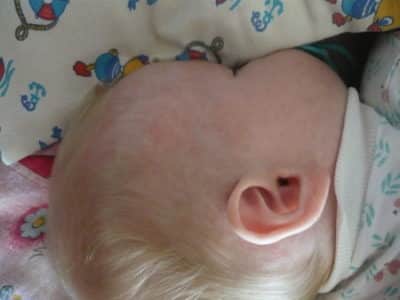
If the anomaly goes further and affects large vessels (veins and arteries), the situation becomes more serious -
Hemangioma is considered a benign tumor. Often, neoplasms go away on their own, developing to a certain size and entering the stage of reverse growth. Experts distinguish the following types of hemangiomas:
- simple - located on the surface of the skin, mainly on the back of the head, the boundaries are clear, it grows in breadth. If you gently press on the tumor, it will turn pale - the blood will be squeezed out of the vessels in this area and the skin will acquire a normal color;
- cavernous - in this case, the spot gains volume and significantly decreases in size. A semblance of a nodule of blood vessels appears on the head, and the nodule is located very close to the skin. When pressed, it also turns pale, but returns to color after stopping the pressure;
- combined - has all the signs of the above hemangiomas, but the problem still affects only the vessels;
- mixed - the same as combined, only not only the vessels swell, but also the tissues that are located next to them, which is why the formation rises slightly above the skin.
If the tumor is already quite large and does not intend to stop growing, the doctor may suggest surgery to remove it - in this case, it is better to listen to his arguments and make the right decision. According to statistics, only thirty percent of all tumors needed to be removed.

Angiodysplasia is absolutely not dangerous, but from a cosmetic point of view it can cause serious problems for the child. The first spots usually appear on the forehead and continue to grow with the baby. As a result, spots of different shades of red appear all over the child’s face: from soft pink to purple. The spots are a consequence of a malformation of the circulatory system and can only be cured with timely consultation with a specialist.
Why does a child have a red spot on the back of his head?
The main reason for the formation of angioma of any type is a violation of vascular development in the prenatal period. It is worth considering that if such spots bothered the expectant mother during pregnancy, there is a high risk of pathology developing in the child. Experts are not entirely sure why circulatory problems occur. Some attribute this to the action of external negative factors, others argue that these are the consequences of past infectious or cold diseases.
The formations are represented by characteristic single or multiple spots, their color varies from pink and almost flesh-colored to purple and even blue. They are covered with a thin layer of skin and may look like a slight swelling. When punctured, blood is released (in the case of lymphangioma, a colorless liquid).
In addition to the clinical picture, there is a clear sign that this is an angioma. When pressing on the red spot, the formation becomes discolored or becomes very pale (this does not apply only to severely deformed and neglected cavernous hemangiomas). This confirms the fact that it is the vessels and not the tissues that are affected. Despite the ease of diagnosis, a final diagnosis can only be made by a doctor.

Symptoms of balanoposthitis in infants
Symptoms of balanoposthitis in an infant are clearly visible and obvious. The small head of the penis becomes brightly inflamed and swollen. Red spots often appear on it. The child turns from calm to very fussy, which is quite understandable. Even with regular diaper changes, noticeable diaper rash appears in the folds of the skin. They do not react in any way to creams and powder, because they are caused by completely different reasons. This type of diaper rash precedes balanitis in newborns.
Signs of a yeast infection in infants appear not only on the penis, but also in the mouth. It looks like there are little milk clots stuck in there. These are typical signs of balanoposthitis in newborns. When he swallows food (mother's milk), this yeast enters the digestive system and is then released through urine into the diaper. A humid environment is a great place for candidiasis to develop. If a child has stomatitis, you should not expect it to disappear on its own. It itself can only develop into balanoposthitis in a small infant.
Conservative and surgical treatment of angiomas depending on their type
In childhood, treatment of tumors is carried out very rarely, only if for some reason the tumor grows rapidly or causes significant discomfort. There are surgical and conservative treatment options for the condition. Angiomas very rarely degenerate into malignant formations, but if this happens, complex therapy is needed (removal followed by chemotherapy).
- Wine stains can disappear on their own only if they are small in size. From a physical point of view, they are harmless, but can cause serious mental disorders if they grow so large that they affect the neck and even spread to the face. Then they are removed with a laser.
- Capillary hemangiomas can be eliminated conservatively (taking hormonal drugs), but only if absolutely necessary. Surgical techniques are not recommended, as this can lead to extensive scarring.
- Cavernous hemangiomas are the most unpleasant type of red spots. They can bleed and become covered with ulcers, which is especially unpleasant when located on the back of the head. In children, they are eliminated by taking prednisolone in minimal doses. Sometimes the technique of electrocoagulation or surgical excision is used.
- Spider hemangiomas are treated very rarely and only for aesthetic reasons. They are destroyed using electrocoagulation.
- Lymphangiomas can be removed surgically, but this involves too much tissue. For this reason, experts prefer not to touch the formations.
Useful: Why is general anesthesia dangerous for a child?
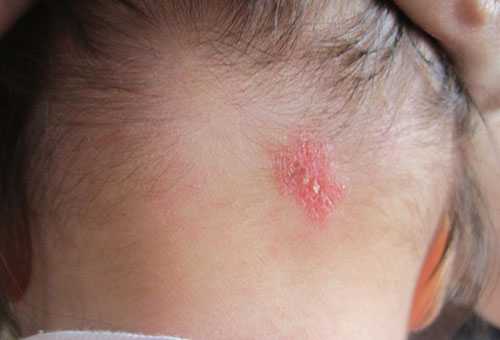
Manifestation of atopic dermatitis in a child
Causes of the phenomenon
The reasons for the appearance of reddish spots may be as follows:
- allergy to any food - any new product introduced into the baby’s diet can cause red spots to appear. If it really is a food allergy, the red spots on the baby's head constantly become wet and blistered, causing discomfort and constant itching, which intensifies when the blisters burst and the wound becomes covered with scabs;
- a reaction to medications taken - antibiotics and even simple vitamins can cause the appearance of harmless “medicinal” spots that disappear after stopping the medication. During a routine examination, the pediatrician should tell you whether it is possible to continue taking such pills or whether it is better not to risk the child’s health;
- heat rash - if a child often overheats or rubs his head on a rough surface, spots may appear that look like burns, but are not so painful;
- dermatitis - manifests itself due to exposure of the child to chemicals. Not necessarily directly - the disease can manifest itself even if an unsuitable powder or bed linen conditioner was chosen for the baby;
- infection - if, in addition to red spots, the child has chills and other alarming symptoms, it is necessary to urgently call an ambulance, because red spots on the head are the least of the problems that parents will have in the near future.
A consequence of the development of atopic dermatitis, lichen or common miliaria
The appearance of red spots on the back of the head is not always a consequence of vascular dysfunction. Sometimes it can be caused by other diseases.
- Lichen. Characterized by red spots that do not itch. The disease is quite unpleasant, and children, even with quality treatment, can suffer from it for about two years. Special ointments are used for therapy.
- Atopic dermatitis. If the spots itch and are accompanied by peeling, this may indicate a malfunction of the digestive tract. The main treatment method in this case is diet. The nutrition of the mother (if the baby is still breastfed) or the child itself is adjusted. Chocolate, black currants and strawberries, citruses, nuts, mushrooms, cocoa, sweets and smoked products are completely excluded from the diet. Meat can only be consumed boiled; fish broths are not recommended. Honey is allowed in minimal quantities. Additional drug therapy is often required.
- Sweating. It is the result of improper child care. The baby sweats, and irritations form that take the form of spots. Sometimes powders with bactericidal properties are used, the baby's head must be ventilated regularly, and he is only allowed to go outside wearing a hat.
Such skin formations are rarely dangerous, especially if you consult a doctor in a timely manner and follow all the specialist’s instructions. The main thing to remember is that the use of any drugs prepared according to traditional medicine recipes can worsen the situation and turn a temporary phenomenon into a permanent defect.
Treatment of balanoposthitis in infants
Treatment of balanoposthitis in a child must be agreed with the pediatrician and takes place only under his supervision. Nystotin is an excellent anti-yeast drug. The pediatrician prescribes this medicine to eliminate an infection that has caused inflammation of the foreskin of a newborn. Ibuprofen may be prescribed to reduce pain and swelling. When caring for the skin near the genitals, you need to ensure that it is always dry. If inflammation occurs, it is better not to use wet wipes, which can irritate the delicate skin. It is better to temporarily abandon the foam that is used when taking baths.
The pediatrician recommends that breastfeeding mothers use nystatin to treat the nipples to eliminate the possibility of infection through feeding. Bottle nipples, pacifiers and toys that your baby can put into his mouth should be sterilized after each use. And most importantly, monitor every urination of the child in order to change the diaper on time.
Red spots on a child’s head often appear, and this symptom is not always harmless - in this regard, you should not trust the experience of young mothers for whom everything worked out well, and the spots themselves appeared because the child screamed for a long time. In some cases, rashes become harbingers of really serious diseases, so it is better to play it safe and consult a specialist, because we are talking about the baby’s health.
Causes
There can be many reasons, here are the most common:
- Bad ecology. Red spots on the back of the head may be a consequence of the mother’s poor nutrition during pregnancy or failure to adhere to the correct daily routine. Dirty air, lack of oxygen - all this affects the health of not only the mother, but also the unborn child. There is only one solution to this problem. If you don’t want your baby to have a red spot on his face or the back of his head, you need to spend maternity leave outside the city, eat right and follow a daily routine.
- While carrying a child, the mother must closely monitor her health. Rubella, chickenpox, and influenza can greatly undermine the condition of the baby’s internal organs inside the mother’s womb. Often red spots on the back or back of the baby’s head indicate that the mother suffered some kind of illness during pregnancy.
- If a woman does not go on maternity leave until the birth, but continues to work, then it is very difficult to manage without stress. Frequent nervous situations negatively affect the health of the mother and the unborn child. A red spot can be the cause of stress.
- We must not forget about the dimensions of the child. If the baby is large, it is more difficult for him to pass through the birth canal. The mother's internal organs and pelvic bones press on it from all sides, so the red spot can be a place of stronger impact.


